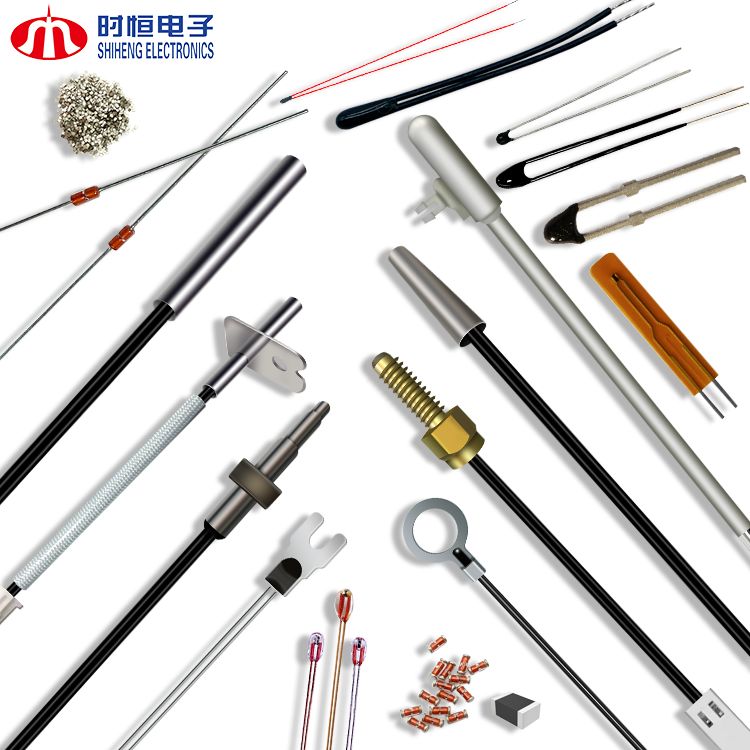何を探していますか?
何を探していますか?
NTC サーミスタを組み込みシステムに統合するにはどうすればよいでしょうか?
Jun 10, 2025組み込みシステムがよりインテリジェントになり、電力消費量を考慮するようになるにつれ、温度を正確に監視する能力が不可欠になっています。電源、モーターコントローラー、バッテリーパック、IoTデバイスを設計する場合でも、温度センサーを統合することは重要です。 NTCサーミスタ リアルタイムの熱管理を可能にするシンプルかつ強力な方法です。
1. 電気的動作を理解する。
NTCサーミスタは温度が上昇すると抵抗値が減少します。温度を読み取るには、通常、既知の抵抗器と分圧回路に接続し、その結果生じた電圧をマイクロコントローラのADCピンで読み取ります。
2. 適切なサーミスタパラメータを選択する。
公称抵抗 (R25): 一般的な値としては 25°C で 10kΩ などがありますが、これは ADC の範囲に合わせて調整する必要があります。
B 値: アプリケーションの温度範囲に基づいて選択します (例: B25/85 = 3435K)。
許容範囲: ±1% または高精度システムの場合は ±2%。

3. エラーの原因を最小限に抑える。
自己発熱:最小限の検出電流を使用する(<熱の発生を避けるために、電流制限(10 µA)を設けてください。
ADC 解像度: ADC ビット深度が高いほど、温度解像度が向上します。
リファレンスの安定性: ドリフトを減らすには、安定した電圧リファレンスを選択します。
ボードレイアウト: アナログ トレースを短くし、スイッチング コンポーネントから離します。
4. 実際の機能:サーミスタは実際には何をするのでしょうか?組み込みシステムでは、サーミスタは監視機能以外にもさまざまな役割を果たします。
ハードウェア保護: サーミスタが過熱を検出すると、システムはシャットダウンするかパフォーマンスを低下させて永久的な損傷を防止します。
熱補償: アナログ回路では、温度に依存する変動はサーミスタ フィードバックを使用して補正されます。
パフォーマンスの最適化: ファン、充電器、バッテリー回路では、サーミスタが動作を制御して温度を安全な範囲内に保ちながら効率を最大化します。
データ ロギング: 一部の IoT デバイスは、サーミスタの精度に応じてパフォーマンスを追跡するために温度の履歴測定値を保存します。
5. 設置のベスト プラクティス: サーミスタの有効性は、その設置方法によって大きく異なります。
熱接触: 表面または接触感知の場合、サーミスタが監視対象の表面にしっかりと押し付けられているか接着されていることを確認します。
空気流の検知: サーミスタを、空気の読み取り値を歪める可能性のあるヒートシンクやコンポーネントから離して配置します。
プローブの用途: 筐体または液体チャネルに挿入するには、エポキシまたは金属チップのプローブを使用します。
SMDマウント:使用時 表面実装サーミスタはんだ付けが十分であることを確認し、局所的なバイアスを避けるために熱を発生する IC から離して配置します。

NTCサーミスタは、組み込みシステムにおけるリアルタイム温度フィードバックのための、コンパクトでコスト効率が高く、高精度なソリューションを提供します。適切に設置し、スマートな設計で使用することで、コンポーネントの保護、性能の最適化、製品寿命の延長を実現します。
プロジェクト用のサーミスタの選択やカスタマイズについてサポートが必要ですか? Shiheng Electronicsへのお問い合わせ エンジニアリング サポートと迅速なサンプル提供のため。